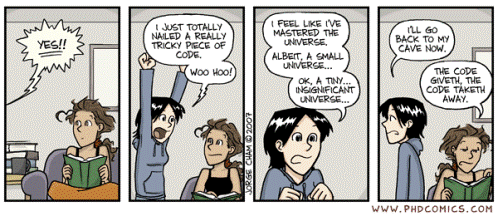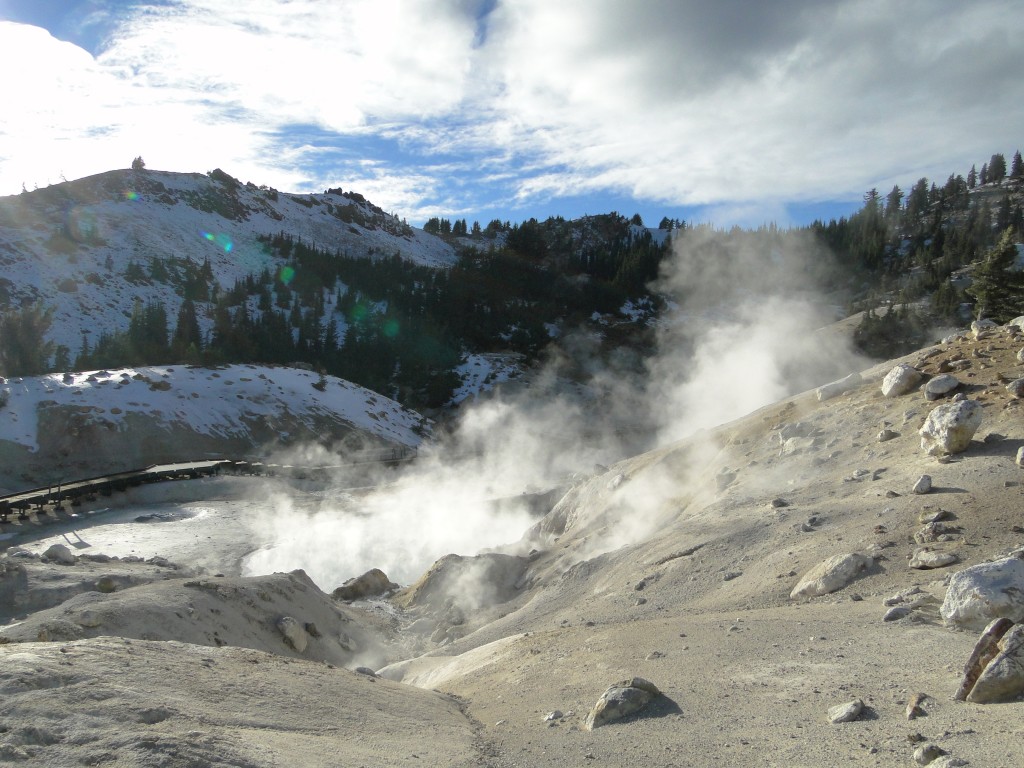One of my New Year’s resolutions was to talk more about my research, and I thought it would be good to start with my basic elevator speech: I study how water and heat interact in stratovolcanoes, and how that can make them unstable even if they’re not erupting. Now, that’s a very simple way to put it even if it doesn’t follow the “thousand most common words” rule, but it’s not a bad start. To get more detailed, here’s a shortened version of the description for my Mendenhall postdoc (if you want the whole shebang, it’s archived online here):
We seek a postdoctoral fellow with strong quantitative skills to elucidate and develop the linkages between geophysical imaging of the interior of volcano edifices, characterization of water distribution and rock shear strength properties, and the hydrologic processes triggering massive edifice instability. This approach has the potential to significantly improve our understanding of the processes that lead to flank collapse, lahar generation, and phreato-magmatic eruptions. Some fundamental questions that might guide this effort include:
- How do physical properties, such as rock magnetism and electrical resistivity, relate to degree of water saturation and argillic alteration within an edifice?
- What are the mechanisms for storing and releasing water within a volcano and how are aqueous fluids distributed vertically and laterally within the edifice?
- Given that the 3D groundwater pressure distribution within an edifice directly affects flank instability, can coupled heat and groundwater flow models utilize geophysical constraints on water distribution to provide such a pressure distribution?
- How do heat, fluid pressure, and mechanical deformation interact to modify fluid transport properties and strength characteristics within the whole and fractured edifice, and how might this modify the timing and style of slope failure?
- Given that edifice failures can occur with or without hydrothermally altered rocks, to what degree does weakening from alteration promote and localize 3D slope failure?
- Can targeted, site-specific geophysical surveys better characterize parameters controlling flank instability?
That’s a lot to absorb – so here’s the breakdown.
Though volcanoes are exciting because they erupt (boom!), interesting things also happen to them long after they’re through being active. Water, in particular, plays an important part in what happens inside an otherwise quiet volcano. A volcano’s hydrothermal system (the paths that hot water and vapor and sometimes gases follow inside a volcanic edifice) can have interesting effects on the rock, including making it more prone to collapsing.
One reason for this has to do with the fact that hydrothermal alteration minerals, especially clays, behave differently than the mineral assemblages they formed from. They’re not only weaker, but they can create permeability contrasts that control the movement of water and gases inside a volcano, and they can also (in the case of shrink-swell clays like montmorillonite) hold a lot of water in and of themselves. In order to make these minerals, you need a combination of hot water (but not too hot; a lot of clays form around the 200°C mark), acidic gases, and enough time for the processes that form alteration to occur. This can depend on things like the supply of heat and gas from a magmatic source, the availability of water (usually from a meteoric source), the permeability conditions inside the edifice, and the time water has to participate in these processes (which is connected to how permeable the rocks are).
An example of a surface manifestation of a volcanic hydrothermal system at Bumpass Hell, Lassen Volcanic National Park. A lot of the volcanic rock here has been altered to much weaker minerals (like clays), which form the gentler slopes as opposed to the steep cliffs and slopes in the background.
All of these factors can combine to affect the stability of volcanic slopes on a variety of scales. My PhD was all about how these processes operate in lava domes, which are structurally different than stratovolcanoes but made up of the same materials and subject to the same hydrothermal processes. At the field area I examined, the Santiaguito lava dome complex in Guatemala, it turns out that there’s a limited amount of clay formation going on in the domes, mostly because the water in their hydrothermal systems passes through them without having time to equilibrate chemically with its surroundings, and because there seems to be very little acid gas in the inactive domes, which means processes like clay formation operate much more slowly. Short residence times + little acid = limited clay formation, and when we looked at satellite spectral data of the complex, we saw that most of the secondary mineralization was hydrous silica. That’s what you get when you dissolve silicic rocks in hot water and then let the water cool, precipitating the silica out of solution. So, I didn’t find significant alteration on the domes in my field area, which is pretty good for stability (in fact, the hydrous silica might act as a kind of cement to make some of the exposed erosional surfaces a little more stable).
One of the problems with doing field work on any volcanic edifice is that it’s difficult to get information beyond the surface, and that’s where the second half of my thesis and my current postdoc come into play. When we can’t directly see or sample what’s going on underground, we have to resort to numerical modeling and geophysical surveys. The second half of my PhD was some pretty serious modeling of an idealized lava dome geometry, trying to figure out – based on the most reasonable inputs and boundary conditions we could come up with – how water and heat move through a cooling dome once it’s no longer actively erupting. I’m doing the same sort of thing now, but with a model that has some different capabilities, and on stratovolcanoes instead of domes.
In these kinds of (groundwater) models, choosing your inputs, material properties, and boundary conditions are key. Numerical models solve physics-based equations that describe how different substances should behave when different conditions are set, and the results you get depend entirely on what information you feed into the model. Ever heard the phrase “Garbage In, Garbage Out” applied to programming? Same thing holds for geologic modeling. I spent a very long time tracking down values for the properties of volcanic rocks that my model used; some, like density and thermal conductivity, were pretty easy, while others like permeability and porosity varied widely. Permeability in particular was a problem, because it exerts a huge control on groundwater flow, and because most laboratory measurements are made on hand samples and not bulk samples, which would be more representative on the scales I work at.
So why is it important to know about how groundwater flows through hot (or cold) rock? One big reason is pore pressure. Elevated pore pressures in a slope of any kind can counteract the normal stresses on the slopes, reducing the factor of safety and making collapse more likely. In the case of volcanoes, you could get elevated pore pressures in saturated rocks by introducing heat from a magmatic intrusion (see Reid 2004 for one scenario). Because hydrothermally altered rocks have the potential both to hold a great deal of water and to direct its flow paths in volcanoes, the interplay between internal heat, the location and character of alteration, and the resulting responses in pressurization are very valuable things to investigate – and that’s what I’m doing!
Eventually, I hope to apply this all in a hazards perspective and look at specific scenarios for the volcanoes we already have geophysical data on. Right now I’m digging into the groundwater modeling by building on previous investigations of the hydrothermal systems in Cascade stratovolcanoes (you may occasionally see me lamenting the ‘debugging’ process on Twitter). The modeling process, as one of my supervisors describes it, is long periods of setting up and testing different inputs, many of which crash the model or give you unreasonable results, punctuated by brief periods where everything falls into place and you get a batch of results all at once. It can be quite frustrating, especially when you find a mistake that means you have to re-run something you thought you were finished with, but in the end I hope to come up with some really useful output that will help me tackle a few of the questions above. In short, I spend a lot of time doing this:













/https://tf-cmsv2-smithsonianmag-media.s3.amazonaws.com/filer_public/34/31/3431771d-41e2-4f97-aed2-c5f1df5295da/gettyimages-1441066266_web.jpg)






Discussion about this post